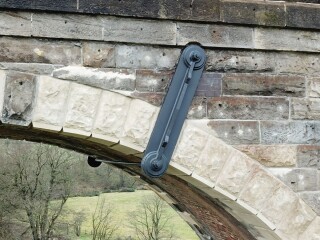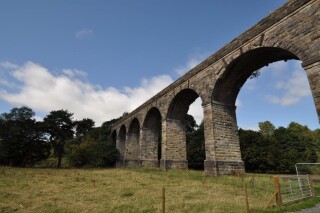As the video below shows, the 16-arch viaduct that straddles the River Avon on the West Lothian and Falkirk border has been returned to its former glory thanks to a £2m renovation programme funded by Historical Railways Estate (HRE).
Work on the Westfield Viaduct, led by main contractor Balfour Beatty, included masonry repairs, waterproofing and the installation of 19 bat bricks, six bat tubes and two bat boxes. It took 18 months to complete and should see the structure, built in the 1850s, stand for a few generations more.
HRE civil engineer Colin McNicol said he was pleased with how well the work had gone. “The viaduct had numerous issues that needed attention to ensure it remained safe and in good order and the work that has been completed makes any future plans to reopen the viaduct as an active travel route for pedestrian, cyclist and other users a real possibility,” he said.
Westfield Viaduct is among the 3,100 former railway structures maintained by National Highways Historical Railways Estate (HRE) on behalf of owners, the Department for Transport. Even though National Highways has no remit for highways in Scotland – that is a devolved government matter – it still looks after railway viaducts there that are no longer in use.
Westfield Viaduct was constructed between 1854 and 1855 as an extension of the Monkland Railway. This branch line ran from Blackston Junction on the Slamannan Railway to Bathgate to meet the Wilstontown, Morningside and Coltness Railway before turning west to ran to mines around Crofthead before becoming part of the North British Railway in 1865.
The structure has 12 large arches of about 47ft span and two small ones at each end. In total it stretches for 660ft over land and water and stands 60ft from the top of the arch to the riverbed.
Before renovations could begin two rounds of bat surveys were carried out at different times of year, including a summer re-entry survey to ensure bats had not returned to work areas for hibernation. Surveys included abseilers under the direction of bat-licenced ecologists checking crevices in the masonry with endoscopes (a long thin tube with a camera inside) for signs of bat activities. Drones were used for further checks.
Any crevice that showed signs of bat droppings or dark stains on the stones, and crevices that were too difficult to survey properly, were fitted with excluders that allow bats to leave but not re-enter. All the surveys were completed under a NatureScot bat licence.
Temporary bat boxes, tubes and bricks were installed on areas of the structure where work was not taking place for bats to use safely during the hibernation season. Multiple bat bricks, boxes and tubes were then built into the viaduct as permanent bat roosts.
Other work included extensive vegetation clearance and repairs to all 16 spans, along with north and south parapet repairs and waterproofing work. New cast iron pattress plates, manufactured to match the originals, have also been installed to replace damaged elements and stone repairs were colour matched to the original unweathered material.

National Highways’ HRE team is usually under fire in the media for somewhat cackhanded shortcuts in its Victorian bridge maintenance, simply filling in voids beneath arches with rubble and concrete, thus preventing any development of greenway routes along the disused railway alignments beneath the arches.
In June last year, the former chairman and chief executive of the Strategic Rail Authority, Richard Bowker, was so incensed by what had happened to Great Musgrave Bridge in Cumbria’s Eden Valley, he said: “I’ve never been big on ‘and now heads must roll’ but, on this occasion at least, the CEO of National Highways must formally apologise as well as scrap this policy of unwarranted vandalism.”

National Highways has defended itself against criticism of its bridge infilling. A spokesperson said: “National Highways has been responsible for looking after more than 3,100 structures and assets in the Historical Railway Estate, owed by the Department of Transport, since 2013. The vast majority of our work involves repairs, other strengthening works and restoration schemes, which we have carried out on hundreds of structures. By comparison, we have completed infill work on 52 structures, all to make them stronger and safer for the public to use.”
The HRE Group, an alliance of engineers, sustainable transport advocates and greenway developers, has been orchestrating the campaign against the bridge infilling. However, on this occasion it was, for once, full of praise.
HRE Group spokesperson Graeme Bickerdike said: "The Avon Viaduct near Westfield is one of the most striking structures of the nation's Historical Railways Estate. Decades of neglect had left much of its stonework in a degraded condition, whilst vegetation growth and unsightly brick repairs added to the sense of dilapidation. This significant investment in the viaduct's refurbishment is great news and we welcome the sympathetic nature of the work that's been undertaken by National Highways' contractors. Let's hope that proposals come forward to repurpose the structure for community benefit, acknowledging its status as an infrastructure asset and outstanding heritage feature within the landscape."
Replacing the pattress plates
![How the stonework looked before the repair [Photo ©The HRE Group] How the stonework looked before the repair [Photo ©The HRE Group]](https://www.theconstructionindex.co.uk/img-cache/62372f6a559dd0345a8c13addf1928cb/320x212.53333333333_1677586176_westfield-3©thehregroup.jpg)
Millar Callaghan Engineering Services was awarded the contract to replace the damaged and broken pattress plates and tie rods that bind the structure together at the top of the 16 arches.
A detailed survey ascertained detailed dimension and design of the existing steel cast iron plates to the new replacement plates would exactly match. The new plates and tie rods were fabricated in Millar Callaghan’s Irvine workshop.
A spider crane was positioned on top of the viaduct to assist with the removal of the old, and installation of the new, pattress plates. Powered access platforms were used to access both the outside face and the underside of the arch to remove and install steelwork.
The old cracked and damaged plates removed were removed with care and skill to ensure that they did not break apart during removal. The new plates and tie rods were then installed and torqued up into position. A fresh coat of paint was applied to freshen up both the new and existing steelwork.
Got a story? Email news@theconstructionindex.co.uk



